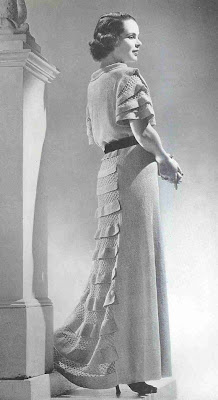Can you imagine knitting this?
As someone just starting their first knitted item, a scarf, in about five years, I cannot. But I am inspired. I imagine that in the 1930s knitting needles were much easier and cheaper to come by than sewing machines. Maybe that's why knitting was so popular. It's also safer and easier to do than sewing when small children are around, and you can do it almost anywhere. Even outside in the garden with the pets.
 |
| Mary Boyd knitting with cat and bird on her knee, near the 400 gallon water tank, country Victoria, 1924 |
But what of the needles themselves? Antique knitting needles were sometimes made from tortoiseshell, ivory and walrus tusks - materials are now banned due to their impact on endangered species. During the 1920s and 30s most knitting needles were made of wood, metal (nickel plated steel), celluloid (also known as Xylonite), or Galalith plastic, made from casein (the protein in cows milk) in a wide range of colours.
Double-pointed needles are the oldest form of knitting needles, used as early as the 14th century. They are tapered at both ends, which allows them to be knitted from either end. From the 1920s they typically came in sets of four to six, in shorter lengths than other needles, and were used for circular knitting such as sleeves, collars, and socks. I love this pair.
In the 30s the circular needle became popular, a long, flexible double-pointed needle that can be used for both flat and circular knitting. They have two tapered rigid ends connected by a flexible strand allowing the two ends to be brought together.
Other knitting accessories such as gauges were given that special 30s touch, in either colour or design. Often needles did not have the size or number wirtten on them, so a gauge was essential. This cardboard spinning wheel from the 1930's (about 1935) was used for sizing knitting needles and crochet hooks plus as a stitch gauge. The black top portion rotates around to match the perfect size and also what yarns to use (the BOYE size as well as mm.) and another part shows the stitches per inch. The reverse side has "Don'ts" for knitters as well as knitting tips.
The Patons beehive gauges of the 1930s came in a wide range of colours and were made of Bakelite.
Vintage knitting needles and accessories are highly collectable. The Beehive gauge, for example, can be bought for just under $50! If you love vintage knitting needles, but don't knit, you could always get something like this:
No good needles were harmed in the making of these bracelets apparently, they are usually wonky to start with.
Deb xx














No comments:
Post a Comment
Your comments are very important to me and I read each and every one of them! Please leave your blog address so I can visit.